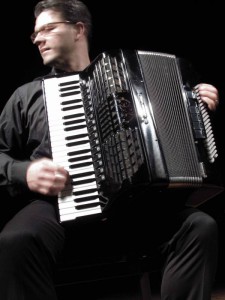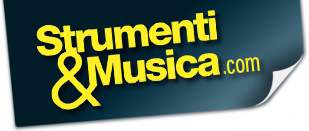 George Dellarole teaches accordion at the Music Institute of the Valle d’Aosta. With its concert activity has brought the accordion in prestigious venues, giving concerts throughout Italy, Europe, China, Africa and the United States and recorded for RAI 1 and Radio 3 (“The Music Room” and “Green Square”), for the African International Television and national broadcasters Polish and Greek.
George Dellarole teaches accordion at the Music Institute of the Valle d’Aosta. With its concert activity has brought the accordion in prestigious venues, giving concerts throughout Italy, Europe, China, Africa and the United States and recorded for RAI 1 and Radio 3 (“The Music Room” and “Green Square”), for the African International Television and national broadcasters Polish and Greek.
He played in the first performance, among others, songs by Nicola Campogrande and Angelo Gilardino and collaborates with musicians such as Fiorella Andriani, Louis Attademo, Bruno Cavallo, Gabriele Geminiani, Lorenzo Micheli, Alessandro Palmeri, Rocco Parisi, Emanuele Segre and Alexander Tampieri.
In recent years he devoted himself mainly to the study of baroque and classical repertoire bringing, among the first, his instrument to the attention of the specialists of the genre and spreading among accordionists, through seminars and master-classes, the idea of a rigorous research philological and stylistic applied to early music.
When did you start playing and why?
I started when I was 7 years old. Intrigued by the story of my parents, not musicians, a performance by an orchestra of accordions that had affected them very much, I tried to get close to the accordion and struck the spark. The decision to make music my main occupation, however, was rather late and has only gained while attending the last years of high school.
What is the most common image of the accordion in the collective international?
It seems to me that, despite the efforts and the undeniable progress of the accordion movement, the idea still prevails in the collective imagination of an instrument related to the celebrations. It must be recognized, however, that many people of different cultures and social backgrounds admit to having been deeply touched by the expressivity of the accordion, and perceive a sense of familiarity even when they discover as “classic” instrument.
Its image and its tradition change from country to country?
Certainly, because customs vary and are very different paths that the tool has followed in its development tumultuous last thirty years. In my experience, however, even in countries with a high quality accordion movement (think of Germany, for example), remains strong imprinting popular instrument.
From early music to tango, klezmer , programs and even for solo accordion quartet. It is the tool that fits all or is it more a question of method, approach to music?
For me, for a good part of my musical career (at least until 2005) I tried to play on the great possibilities of adaptation of my instrument, both in the choice of programs, both in the exploration of different kinds of music and so I definitely advantage of the characteristics of the accordion, with a large opening to all the stimuli I received. I thought that my choice was functional to the historical moment that the accordion crossed in the ’80s and ’90s. At that time the instrument was struggling to get out of the narrow confines of the popular repertoire and could, in my view, to assert the public eye as a tool eclectic and adaptable to different circumstances, I thought also that practice the most disparate musical genres would allow me to acquire a repertoire of knowledge and valuable training. In the last decade, however, I felt the need to delve into some topics, focusing my attention on the study of ancient music (more or less the period from Frescobaldi to Mozart) and the consolidation of my teaching methodology.
In which directories you can express the full potential of your instrument?
Surely in the repertoire of quality designed specifically for accordion feel that the instrument “works” at best and fully realizes its potential. That said, I think the size of chamber music in general, which for me is to work with small formations from duo to sextet, it fits very well to the modern accordion. I also believe that the characteristics of the accordion can make the most of the voices and the instruments with which it interacts.
In which directories you are most comfortable with?
I’m always more comfortable in the performance of solo and chamber music repertoire, to which I devote most of my energy for about ten years now, even though, sometimes, I have the feeling of having to “bend” my instrument to achieve an adequate stylistic consistency. It is a musical genre still largely unexplored from our point of view: on the one hand, we need to devise a way to “say” that is credible and that it fits the accordion, on the other hand we must have the courage to make choices and resign ourselves to the fact that some songs, maybe important and interesting, accordion simply do not work.
In general, also, having practiced a lot, I run with pleasure chamber music ensembles, while I worked with orchestras rather rarely more numerous and, in the few cases where it happened, I had some difficulties to adapt, although I must admit my curiosity about this kind of experience. As a soloist, finally, I run a lot and always with great satisfaction the Italian repertoire Pozzoli, Fugazza, Fancelli composers and their contemporaries: I think it is music of great value and I am sorry that is often forgotten or underestimated.
Can you talk about your experience in teaching?
I teach accordion at various levels , for almost thirty years now, and especially since my first job as a professor at the Conservatory (in Messina in 2002-2003), I felt a great need to update me as much as possible and to develop a teaching methodology effective and consistent. To do this I worked in two directions: on the one hand, I tried to grasp the fundamentals, and physiological interpretation, education ‘s keyboard, following courses in piano pedagogy, or simply observing the work of fellow pianist, organist and harpsichordist, I have developed a network of contacts with colleagues accordion teachers, inviting each year a different professor to lecture at the Institute of Musical Pareggiato Aosta, where I teach, thus establishing fruitful collaborations and exchanges of human and professional experiences that have greatly enriched me and my students.
In the past, thanks to a multi-year collaboration with the Musical Youth of Italy, I had the invaluable opportunity to develop some projects with Carlo Delfrati and deepen the work on teaching and pre-adolescent child, in recent years, however, I focused more and more on working with school leavers and graduates on very specific topics, often related to the interpretation of Baroque and Classical repertoire.
There are substantial differences between the Italian schools and those of non-European?
As I said earlier, there are differences between the various accordion schools at the international level and also at the national level, as I have been able to verify through seminars and master-classes that I want more and more frequently in Italy and abroad. I recently met at the bottom of the Belgian reality, given that since 2012 I work as a guest lecturer, with one of the two classes of accordion at the Conservatoire Royal de Mons and saw that, in the face of a strong desire to compete and grow in the teachers’ Conservatory, there is a basic educational system, to load the Academies, which is still too tied to pop music and an image of the accordion rather dated.
In general, I think the quality of teaching accordion in Italy is good on average, although our xenophilia often leads us to enhance the foreign experience and denigrate what we are closer. The recent, I have given the term insane polemic against the accordion keyboard, deemed “inferior” and unworthy of the Conservatives, confirm that the ignorance and, ultimately, self-injury of some Italian accordionists maintain levels of concern. I do not know that things like that happen abroad and I think that, more or less everywhere, although in different ways, it is progressing quite compact in the process of emancipation from the scope of the accordion folk where it was born and where it took his first steps.
What is the project you’re working on at the moment?
It is finally finished off a major recording project in collaboration with Alessandro Tampieri, one of the greatest violinists of the Baroque contemporaries, in which for the first time using my new tool Bugari agreed with the 415hz and in with the scheme Vallotti. The work began in spring 2011 and 27 November last year we witnessed with joy at the exit, in Japan, a CD released by Nichion, soon to be followed by a European version of the same record label curated Belgian “Pasacaille”. The program includes excerpts from the wonderful seventeenth-century Italian repertoire (Castello, Frescobaldi, Cima and others), a sonata by Corelli Opera V and a Bach Sonata for violin and harpsichord obbligato.
I hope to have the opportunity in the future to affect the other programs were born from collaborations on old footage that I have started in recent years (with baroque cello, flute, clarinet and a counter-tenor).
For the rest I’m giving some digressions into pop music with a working quartet (vocals, accordion, piano and bass) on the Italian song of the period between the two world wars and with a program dedicated to Édith Piaf in collaboration with a large instrumental ensemble and two singers.
I also like to make a nod to “Morning in Iowa”, by German Castelnuovo recently discovered by Lorenzo Micheli, guitar player known to all, in which the accordion has a key role as part of an instrumental quintet that accompanies a narrator (in our case the former Dire Straits David Knopfler) performed the world premiere in 2008 and published by the Soundset Recordings in 2013.
Questo post è disponibile anche in: Italian

 English
English Italiano
Italiano 





Leave a comment
You must be logged in to post a comment.